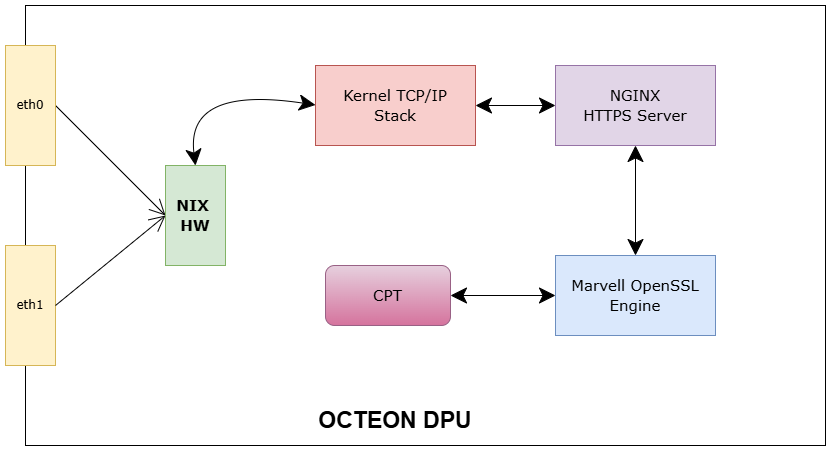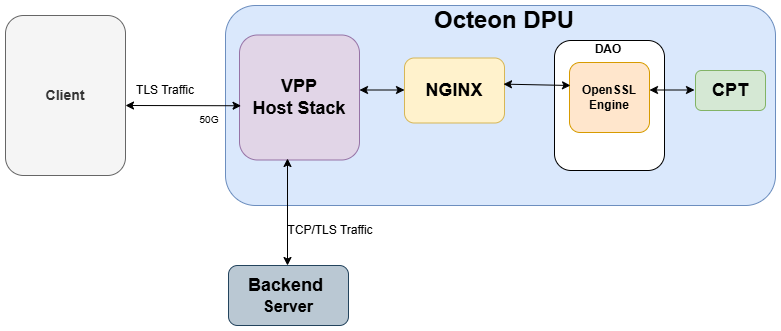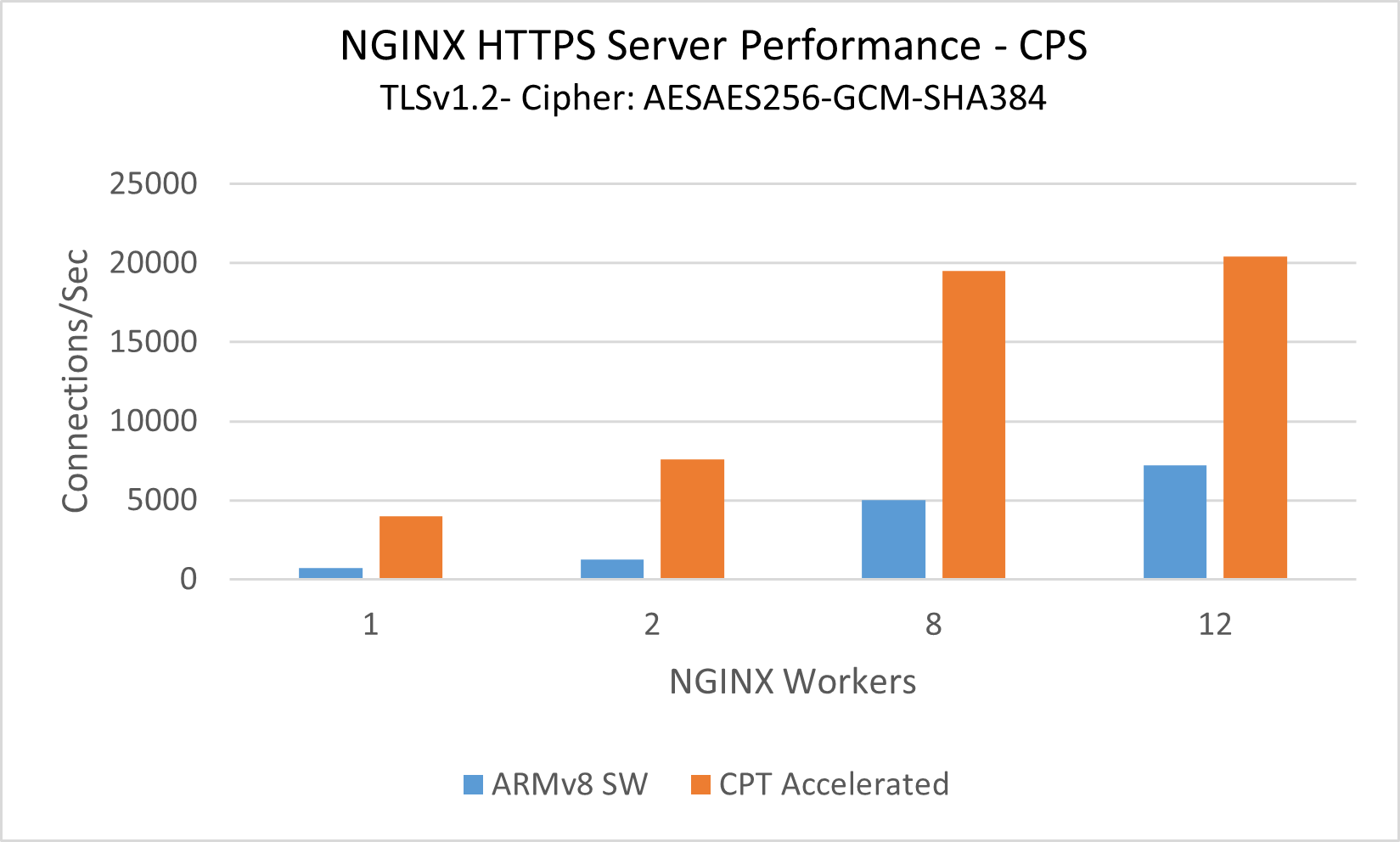NGINX TLS Offload Using OCTEON Crypto Engine#
Executive Summary#
Modern applications rely on HTTPS for secure communication, but software-based TLS processing can overwhelm CPUs and limit scalability. As encrypted traffic volumes grow, cloud and enterprise providers need solutions that deliver strong security without compromising performance or energy efficiency.
Marvell DAO’s NGINX TLS Offload Solution uses the OCTEON DPU’s Crypto (CPT) Engine to accelerate cryptographic operations directly in hardware. Integrated seamlessly through the Marvell OpenSSL Engine, it enables NGINX to offload TLS handshakes and encryption from general-purpose CPU cores to dedicated hardware.
The result:
Up to 5.7 higher TLS handshake rate (CPS).
Up to 45 Gbps (50G Line rate) throughput.
65% lower CPU utilization.
23W peak power consumption.
This makes it ideal for Content Delivery Networks (CDN), Cloud Load Balancer, and Edge TLS Gateway deployments that demand both performance and efficiency.
Solution Overview#
NGINX is the backbone of modern web, API, and proxy workloads. Under heavy TLS encryption, CPU resources quickly become a limiting factor.
Marvell DAO integrates NGINX with the CPT Engine on OCTEON DPUs to deliver high-speed hardware acceleration for cryptographic functions such as RSA, AES-GCM, and SHA. The integration is achieved through Marvell’s OpenSSL Engine, providing a drop-in replacement for software based crypto with no application changes required.
Key Benefits#
Hardware-accelerated TLS encryption and handshake processing
Transparent integration using the OpenSSL engine
Frees CPU cores for application and networking logic
Scales efficiently up to 45 Gbps (50G line rate) at only 23 W power
Architecture & Design#
The DAO framework provides a transparent acceleration path that bridges NGINX’s TLS stack with Marvell’s CPT hardware engine on the OCTEON DPU through the Marvell’s OpenSSL Engine. When NGINX processes TLS traffic, cryptographic operations are initiated via OpenSSL and seamlessly intercepted by the Marvell’s OpenSSL Engine. Eligible crypto operations, such as AES-GCM encryption, RSA signing, or SHA hashing are offloaded to the CPT hardware for execution, while non-eligible requests continue in software without disruption.
The Marvell’s OpenSSL Engine manages the offload lifecycle, including buffer management, request dispatch, and result completion, ensuring low-latency and high-throughput operation. Once the CPT engine completes the operation, results are returned transparently to OpenSSL and NGINX, maintaining full protocol compliance.
Workflow#
Below block diagram illustrates the NGINX configured as an HTTPS server with hardware offload.
Client initiates TLS traffic to HTTPS (NGINX) server.
After TCP connection establishment with the NGINX, client initiates TLS operations(handshake, SSL read & write) using OpenSSL.
Kernel stack on Octeon DPU handles the TCP connection and hands TLS operations to NGINX.
NGINX calls OpenSSL APIs to perform TLS operations.
Marvell OpenSSL Engine detects eligible TLS (crypto) operations for offload.
Marvell OpenSSL Engine creates asynchronous jobs and submits to CPT engine via DPU for execution.
CPT engine performs crypto operations at line rate.
Engine APIs in NGINX application polls for the completed crypto operations from CPT.
Engine resums the asynchronous job once the crypto operation results are available from CPT.
Marvell OpenSSL Engine delivers the processed/finished jobs back to NGINX.
NGINX completes the TLS operation and responds back to client.
This design achieves high throughput, low latency, and consistent performance with minimal system overhead.
Performance Highlights#
Below graph shows performance results for connections per second (CPS) and throughput (Gbps) tests with different numbers of NGINX workers (ARMv8 cores on DPU). CPS test measures how efficiently the system can perform TLS handshakes and establish secure connections using a small 100B file size.
And the throughput test was conducted with 1GB file size. The small payload size minimizes data transfer overhead, enabling an accurate evaluation of TLS connection handling, CPU utilization, and the crypto offload efficiency provided by Marvell’s OpenSSL Engine.
From the results, the NGINX HTTPS server reaches peak performance of CPT between 8-9 Armv8 cores, highlighting its scalability and efficiency for TLS workloads with crypto offload. And the throughput results indicate that DPU can reach up to 45 Gbps with 12 workers.
Note
The peak performance of the CPT engine for RSA 2Kb signature operations is 20K sign/sec.
Metric |
Software Only |
With CPT Offload |
Improvement |
TLS Handshake Rate (CPS) at CPT Peak performance |
1.0× |
3.9× |
+290% |
CPU Utilization for Peak (20K CPS & 45 Gbps) |
24 Cores |
9-12 Core |
40-50% |
Power Draw at Peak |
60 W |
23 W |
40-50% |
Performance Insights#
CPT engine peak performance achieved with 8–9 ARMv8 cores
Linear throughput scaling up to 12 workers
Sustained efficiency across TLS workloads
DAO Components#
Use Cases#
Cloud TLS Termination — Accelerate large-scale HTTPS handshakes for web services.
CDN Edge Offload — Reduce latency and power usage for distributed secure delivery.
Enterprise Reverse Proxy — Free up host CPU resources while maintaining strong encryption.
Data Center TLS Gateways — Enable secure, high-bandwidth east–west traffic.
Key Takeaways#
Up to 3.9× higher CPS and 65% lower CPU usage achieved with DAO-based TLS offload.
45 Gbps throughput at only 23 W, enabling secure, efficient HTTPS at scale.
Drop-in integration through OpenSSL with no code modifications.
Fully supported within Marvell DAO Release 25.01, ready for production deployments.
How To Use#
Refer DAO page to try NGINX solution in different modes.




